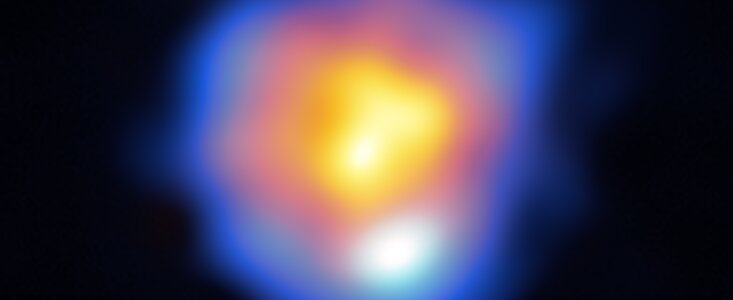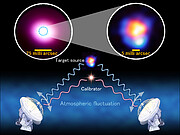Anuncio
ALMA logra sus observaciones de mayor resolución
15 de Noviembre de 2023
El Atacama Large Millimeter/submillimeter Array (ALMA), del que ESO es socio, ha logrado las observaciones de mayor resolución desde que comenzó sus operaciones. Durante una prueba técnica, un equipo de expertos del Joint ALMA Observatory (JAO), el Observatorio Astronómico Nacional de Japón (NAOJ), el Observatorio Nacional de Radioastronomía (NRAO) de EE.UU. y ESO, tomaron imágenes de una estrella evolucionada con una resolución de 5 milisegundos de arco. Esto demuestra que ALMA puede ser utilizado por los astrónomos para observar objetos con un detalle equivalente a ver un autobús de 10 metros de largo en la Luna.
ALMA está compuesto por 66 antenas que pueden configurarse en diferentes posiciones en el Llano de Chajnantor, que se ubica a gran altitud en Chile. Cada una de estas antenas está equipada con receptores que le permiten observar ondas de radio en diferentes rangos o bandas de frecuencia. La resolución de ALMA aumenta tanto a medida que aumenta la separación máxima entre las antenas como a medida que aumenta la frecuencia de las observaciones. Las nuevas imágenes se obtuvieron con la configuración más extendida posible para el conjunto ALMA, con una separación máxima entre sus antenas de 16 kilómetros y utilizando receptores de Banda 10, que permiten a ALMA observar en frecuencias de hasta 950 GHz, las más altas posibles para el conjunto.
Dado que las observaciones llevan las capacidades de ALMA al extremo, su realización fue increíblemente difícil. Si bien los receptores de Banda 10 han estado disponibles en ALMA desde 2014, los astrónomos tuvieron que esperar la validación de una novedosa técnica de calibración, llamada banda a banda, para poder llevar a cabo las nuevas observaciones. Es así como en 2021 hicieron una prueba técnica, donde observaron una estrella evolucionada de la Vía Láctea, R Leporis, utilizando como calibrador un núcleo galáctico brillante, que, aunque distante, aparece cerca de R Leporis en el cielo. Los resultados se publican hoy en la revista Astrophysical Journal.
Este resultado se logró con el importante apoyo del personal de ESO, que participó en las observaciones de prueba, en los experimentos previos que condujeron a este logro técnico final y en el desarrollo de la nueva técnica de calibración.
Más información
Este resultado se presentó en un artículo titulado "ALMA High-frequency Long Baseline Campaign in 2021: Highest Angular Resolution Submillimeter Wave Images for the Carbon-rich Star R Lep", que aparecerá en la revista Astrophysical Journal (doi:10.3847/1538-4357/acf619).
El equipo está compuesto por Y. Asaki (JAO; NAOJ; SOKENDAI), L. Maud (ESO; Universidad de Leiden), H. Francke (JAO), H. Nagai (NAOJ), D. Petry (ESO), E. B. Fomalont ( NRAO), E. Humphreys (JAO; ESO), A. M. S. Richards (Universidad de Manchester), K. T. Wong (IRAM; Universidad de Uppsala), W. Dent (JAO), A. Hirota (JAO; NAOJ), J. M. Fernández (Observatorio Lowell), S. Takahashi (NAOJ) y A. S. Hales (JAO; NRAO).
El estudio técnico previo, conducente a la Campaña de 2021, se puede encontrar en: “ALMA High-frequency Long-baseline Campaign in 2019: Band 9 and 10 In-band and Band-to-band Observations Using ALMA's Longest Baselines”, publicado en Astrophysical Journal en agosto de 2023 (doi: 10.3847/1538-4365/acd6f1).
ALMA es una asociación de ESO (que representa a sus estados miembros), NSF (EE.UU.) y NINS (Japón), junto con NRC (Canadá), NSTC y ASIAA (Taiwán) y KASI (República de Corea), en cooperación con la República. de Chile. El Joint ALMA Observatory es operado por ESO, AUI/NRAO y NAOJ.
Enlaces
Contactos
Luke Maud
ALMA Regional Centre at ESO
Garching bei München, Germany
Tel: +49 89 3200 6765
Email: Luke.Maud@eso.org
Bárbara Ferreira
ESO Media Manager
Garching bei München, Germany
Tel: +49 89 3200 6670
Email: press@eso.org
Sobre el anuncio
| Identificador: | ann23019 |
Our use of Cookies
We use cookies that are essential for accessing our websites and using our services. We also use cookies to analyse, measure and improve our websites’ performance, to enable content sharing via social media and to display media content hosted on third-party platforms.
ESO Cookies Policy
The European Organisation for Astronomical Research in the Southern Hemisphere (ESO) is the pre-eminent intergovernmental science and technology organisation in astronomy. It carries out an ambitious programme focused on the design, construction and operation of powerful ground-based observing facilities for astronomy.
This Cookies Policy is intended to provide clarity by outlining the cookies used on the ESO public websites, their functions, the options you have for controlling them, and the ways you can contact us for additional details.
What are cookies?
Cookies are small pieces of data stored on your device by websites you visit. They serve various purposes, such as remembering login credentials and preferences and enhance your browsing experience.
Categories of cookies we use
Essential cookies (always active): These cookies are strictly necessary for the proper functioning of our website. Without these cookies, the website cannot operate correctly, and certain services, such as logging in or accessing secure areas, may not be available; because they are essential for the website’s operation, they cannot be disabled.
Functional Cookies: These cookies enhance your browsing experience by enabling additional features and personalization, such as remembering your preferences and settings. While not strictly necessary for the website to function, they improve usability and convenience; these cookies are only placed if you provide your consent.
Analytics cookies: These cookies collect information about how visitors interact with our website, such as which pages are visited most often and how users navigate the site. This data helps us improve website performance, optimize content, and enhance the user experience; these cookies are only placed if you provide your consent. We use the following analytics cookies.
Matomo Cookies:
This website uses Matomo (formerly Piwik), an open source software which enables the statistical analysis of website visits. Matomo uses cookies (text files) which are saved on your computer and which allow us to analyze how you use our website. The website user information generated by the cookies will only be saved on the servers of our IT Department. We use this information to analyze www.eso.org visits and to prepare reports on website activities. These data will not be disclosed to third parties.
On behalf of ESO, Matomo will use this information for the purpose of evaluating your use of the website, compiling reports on website activity and providing other services relating to website activity and internet usage.
Matomo cookies settings:
Additional Third-party cookies on ESO websites: some of our pages display content from external providers, e.g. YouTube.
Such third-party services are outside of ESO control and may, at any time, change their terms of service, use of cookies, etc.
YouTube: Some videos on the ESO website are embedded from ESO’s official YouTube channel. We have enabled YouTube’s privacy-enhanced mode, meaning that no cookies are set unless the user actively clicks on the video to play it. Additionally, in this mode, YouTube does not store any personally identifiable cookie data for embedded video playbacks. For more details, please refer to YouTube’s embedding videos information page.
Cookies can also be classified based on the following elements.
Regarding the domain, there are:
- First-party cookies, set by the website you are currently visiting. They are stored by the same domain that you are browsing and are used to enhance your experience on that site;
- Third-party cookies, set by a domain other than the one you are currently visiting.
As for their duration, cookies can be:
- Browser-session cookies, which are deleted when the user closes the browser;
- Stored cookies, which stay on the user's device for a predetermined period of time.
How to manage cookies
Cookie settings: You can modify your cookie choices for the ESO webpages at any time by clicking on the link Cookie settings at the bottom of any page.
In your browser: If you wish to delete cookies or instruct your browser to delete or block cookies by default, please visit the help pages of your browser:
Please be aware that if you delete or decline cookies, certain functionalities of our website may be not be available and your browsing experience may be affected.
You can set most browsers to prevent any cookies being placed on your device, but you may then have to manually adjust some preferences every time you visit a site/page. And some services and functionalities may not work properly at all (e.g. profile logging-in, shop check out).
Updates to the ESO Cookies Policy
The ESO Cookies Policy may be subject to future updates, which will be made available on this page.
Additional information
For any queries related to cookies, please contact: pdprATesoDOTorg.
As ESO public webpages are managed by our Department of Communication, your questions will be dealt with the support of the said Department.


